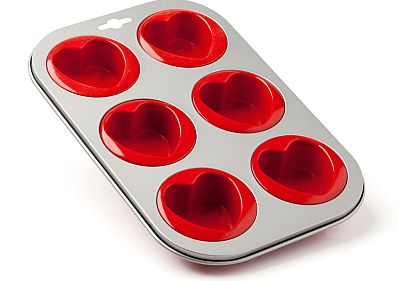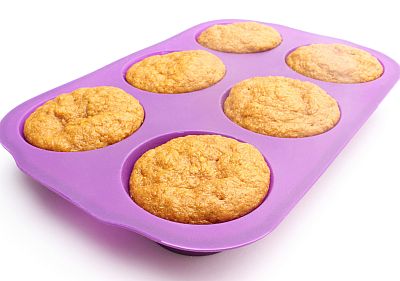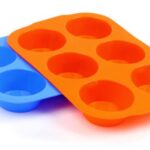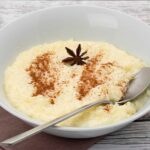Silicone bakeware is becoming very popular nowadays due to its versatility and attractive design. Silicone offers several advantages that outperform traditional baking pans. There are several main reasons why people choose silicone bakeware in their kitchen:
- Durable: Although silicone is lightweight, it is a strong and sturdy material that can last for many years. Utensils can be used over and over again without fear of damage. They won’t fade, wear out, bend, or break if you accidentally drop them.
- Non-Stick capability: Silicone baking pans have an excellent non-stick capability. You don’t need to use fat or baking spray, saving prep time and reducing calories. The baked goods slide out easily and effortlessly.
- Food is baked evenly: The food is baked evenly and browns nicely browned. Unlike metal, a silicone pan stops baking as soon as it is removed from the oven. It cools quickly, making it more convenient to use than some hit-retaining materials.
- Easy to clean: Silicone baking pans are easy to clean because they have a surface that food doesn’t stick to. You can easily clean the pans with warm water and soap, but they are also dishwasher-safe. The pans do not leave any stains and do not retain the smells and flavors of the food cooked in them. The surface has no open pores for bacteria and is also hypoallergenic.
- Temperature resistant: Silicone can withstand a wide range of temperatures and can be easily used for baking, serving, and storing food. It can withstand temperatures from -76 to 500ºF.
- Silicone makes reheating baked goods or leftovers easier. You can put your food in the fridge or freezer, reheat it, and even serve it in the same pan you baked in.
- Ease of storage: Storing silicone bakeware is easy due to its flexibility. The flexibility allows it to be folded and stored easily in any room. A folded object will return to its shape when necessary.
- Attractive appearance: Silicone utensils are available in a wide range of colors and shapes. They are usually made in cool colors so you can serve the food in the same pan it was baked in.
- Affordable: Silicone baking dishes are available at good prices in local stores. With a reusable silicone mat, you can bake without disposable paper, which is also good for the environment.

Are there any Downsides?
- Might be too flexible: Shaking silicone baking sheets can be a problem. Silicone is very flexible, which makes lifting and transferring food into the oven difficult. You may need to use a solid surface for additional stability.
- Spill risk: Liquids are not retained as well as sturdy objects, so burns and spills are more likely. The problem can be solved by using a sturdy baking pan or baking sheet under the silicone bakeware.
- Prone to dust: Silicone utensils build up static and attract dust, so they need to be cleaned regularly.

Is Silicone Safe for Use with Food?
As previously mentioned, silicone products offer numerous benefits, but there is controversy about their safety.
Silicone bakeware is generally considered safe and has been approved by the FDA as a “food-grade substance”. All bakeware must be manufactured to meet FDA standards for food contact safety. Food-grade silicone is non-reactive and should not leach into or harm food in any way. It melts when the temperature rises above the safe temperature range, but does not emit toxic fumes.
Silicone has low chemical reactivity and does not support microbiological growth. Silicone tableware made from food-grade silicone prevents cracking and peeling. There is no evidence that the use of silicone for serving, storing, and baking foods can lead to contamination of those foods. If you use silicone for baking, make sure any pieces you use are food-safe. Also, be sure to read the instructions and use your bakeware properly and within the recommended temperature range. Each piece of silicone bakeware has the maximum temperature marked on it.

Are there still some Concerns Remaining?
Some users have reported odors, but these are mostly due to the use of low-quality and low-quality silicone. It looks like these smells are related to the fillers used in the final product and not the silicone. Baking pans made of high-quality, food-safe silicone don’t produce odors.
You can check your silicone for filler by twisting and squeezing it. If the white color is visible, the product contains fillers. Stop using it and look for higher-quality silicone bakeware instead.
Silicone baking pans are suitable for temperatures below freezing up to 450° Fahrenheit. The safety of silicone bakeware when subjected to repeated and prolonged exposure to high temperatures has not yet been studied. Therefore, long-term studies should be carried out to ensure that the silicone is completely safe for baking in the long term.
In 2007 the Italian magazine Altroconsumo tested silicone pans from various manufacturers on the domestic market for their suitability for food contact. The test showed that a large number of undesirable substances were released from silicone pans when they were used for the first time. The release of these substances was reduced after washing the pan in the dishwasher.
When using silicone bakeware for baking, always choose high-quality items made from food-grade silicone with FDA approval. Be sure to wash new silicone baking molds in the dishwasher before using them for the first time.
Related products:
- Muffin Pan Silicone Brownie Molds – Cupcake Pan by CAKETIME (includes mini 24 cups, regular 12 cups baking muffin tins, and 12-cavity rectangular loaf pans)
- Trudeau Structure Loaf Pan (with integrated steel rim for secure handling)





The silicone ring of my pressure cooker carries the smell of my cooking of the day, even though I washed the detached ring with detergent and plenty of running water. Does this mean the silicone ring a low FG quality? What will be the impact on health if daily meals are cooked under this condition? Thank you in advance for advising.